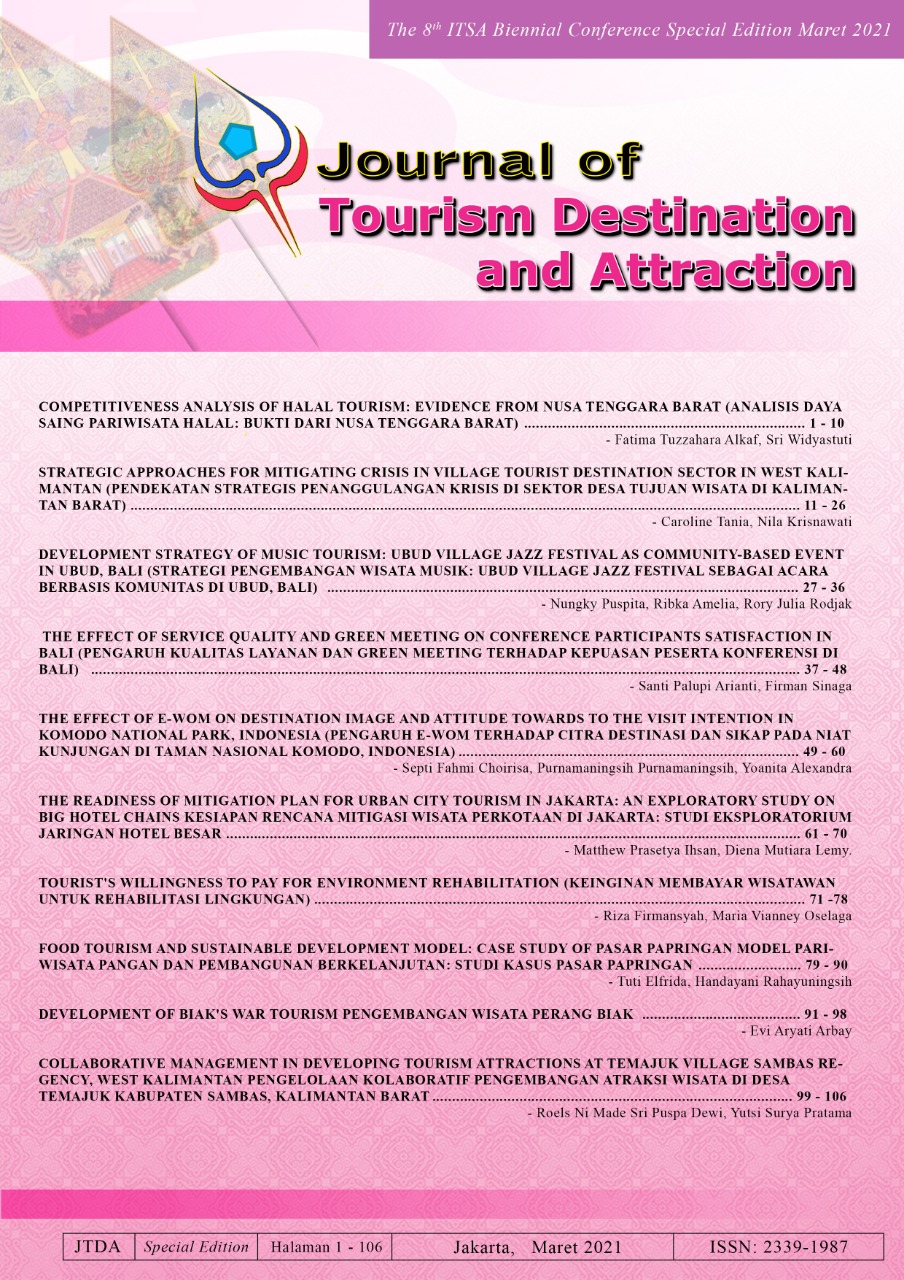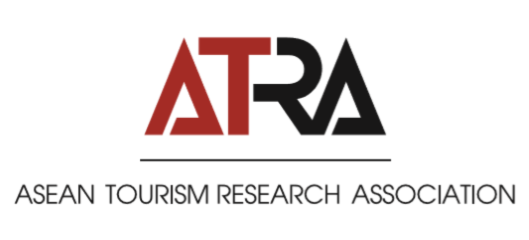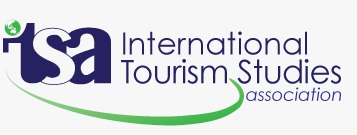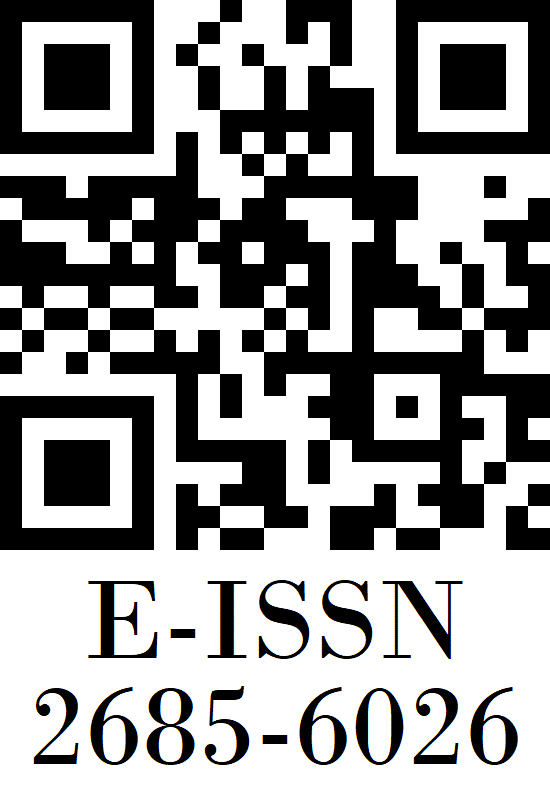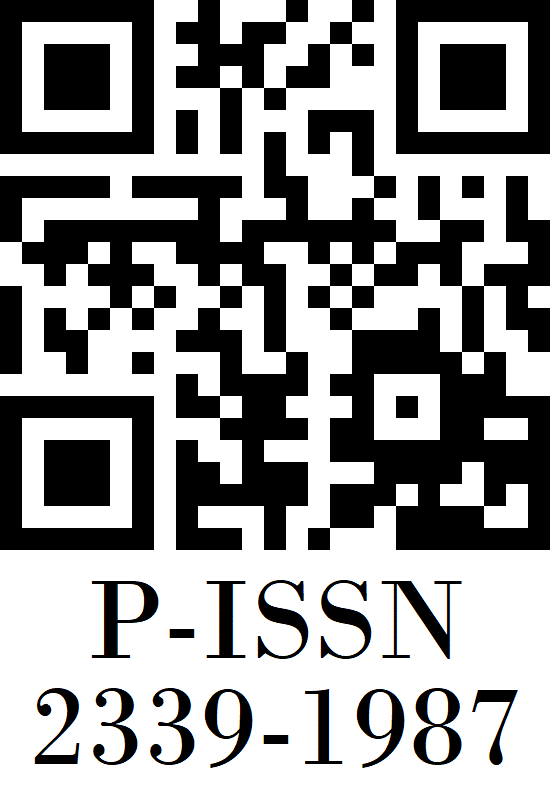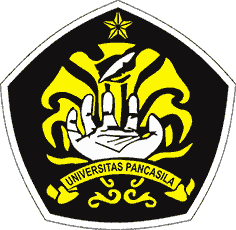THE READINESS OF MITIGATION PLAN FOR URBAN CITY TOURISM IN JAKARTA: AN EXPLORATORY STUDY ON BIG HOTEL CHAINS
DOI:
https://doi.org/10.35814/tourism.v9i1.1878Keywords:
Mitigation Plan, Sustainability, Hotel Chains, Tourism, Hospitality IndustryAbstract
Tourism Industry is one of the biggest industry in the world, especially in Indonesia, tourism has contributed one of the highest earners for the country, but in the third quarter of 2019 the world was faced with a global health threat which results in the lost of tourism income throughout the world due to the regulation and health protocol that were used in order to maintain the worlds stability of health danger, due to the current situation, tourism were highly impacted and hotel industry are one of the most part that were hit hard, that why the purpose of this study is to investigate the mitigation plan readiness of the hospitality industry in Jakarta, focusing on top hotel chains, the readiness. Secondary data collection are used in this research, using desk research from hotel chains latest updated websites in the field of risk management and mitigation plan available. From the research it is found that the Hospitality Industry especially hotels in Indonesia are exposed to crisis, it is becoming increasingly important of having its own mitigation plan and communicating it well to the stakeholders due to the recent pandemic that leads to a lot of loses in the industry, thus not all the hotel chains in Indonesia have communicated their mitigation well to their guest through one of the important communication platform of the hotel which is their official website. In its current iteration, the time was a major limitation and also there is not much research regarding the situation in Indonesia. The study was conducted using secondary data with desk-research method through online data available, which are limited towards the public. Practitioners, researchers and internal stakeholders in the hospitality industry will find the implications of this study useful in the context of the present complex hospitality environment which is fraught with risks. This study is a part of a larger project where the research team is investigating readiness of mitigation plan in the hospitality industry in Indonesia focusing on hotel chains
References
Ahmed, R. (2017). Risk Mitigation Strategies in Innovative Projects.
Akhlas, A. W. (2020a). Indonesia welcomes 16.1m foreign tourists in 2019, coronavirus clouds tourism outlook. Retrieved from https://www.thejakartapost.com/news/2020/02/03/indonesia-welcomes-16-1m-foreign-tourists-in-2019-coronavirus-clouds-tourism-outlook.html?__cf_chl_captcha_tk__=e09bd5cf8ba1a90663c570cf50a141d03e8f81eb-1600413394-0-AX_TG01VCBkfEOSpguV5eXk9bmQ-Lt9ia7MYnsLp_n
Akhlas, A. W. (2020b). Pandemic erases $5.9b of Indonesia’s tourism revenue as businesses seek help. Retrieved from https://www.thejakartapost.com/news/2020/07/14/pandemic-erases-5-9b-of-indonesias-tourism-revenue-as-businesses-seek-help.html?__cf_chl_captcha_tk__=d931989f6ac913f11d063f02f382f5b930a9d11f-1600685120-0-AawPN9BLC5Nj5EUevMj8TUz4GnM-UpM1fjFgwyvnod5by7EW4PiU
Albattat, A. R., & Mat Som, A. P. (2019). Disaster Planning and Preparedness in the Hotel Industry. Disaster Planning and Preparedness in the Hotel Industry. https://doi.org/10.1108/9781787699373
AlBattat, A. R., & Mat Som, A. P. (2013). Emergency Preparedness for Disasters and Crises in the Hotel Industry. SAGE Open, 3(3), 215824401350560. https://doi.org/10.1177/2158244013505604
Amrahi, A., Radzi, S., & Nordin, S. (2013). Hotel internet marketing channels and purchase decision. Hospitality and Tourism, 6(2), 455–459. https://doi.org/10.1201/b16064-90
Bullock, J. A., Haddow, G. D., & Coppola, D. P. (2013). Mitigation, Prevention, and Preparedness. Introduction to Homeland Security, 435–494. https://doi.org/10.1016/b978-0-12-415802-3.00010-5
Camilleri, M. A. (2018). The Tourism Industry: An Overview. https://doi.org/10.1007/978-3-319-49849-2_1
CBI. (2020). How to manage risks in tourism? Centre for the Promotion of Imports from Developing Countries. Retrieved from https://www.cbi.eu/market-information/tourism/how-manage-risks-tourism
Chandrasekera, T., & Hebert, P. (2019). Emergency preparedness in the hospitality industry in Sri Lanka. International Journal of Disaster Resilience in the Built Environment, 10(2–3), 167–174. https://doi.org/10.1108/IJDRBE-01-2018-0001
City of Hotel. (2020). Hotel Chains. Retrieved from https://www.city-of-hotels.com/165/hotel-chains-en.html
Della-Giustina, D. E. (2014). Fire Safety Management Handbook 3rd Edition. CRC Press.
DJS Research Ltd. (2015). What is Secondary Research? Retrieved from http://marketresearchworld.net/content/view/810/
GSTC. (2019). GSTC Destination Criteria, (December), 0–17. Retrieved from https://www.gstcouncil.org/gstc-criteria/gstc-destination-criteria/
Gunawan, D. A., & Jiahao, Z. (2012). EXTRAORDINARY GROWTH OPPORTUNITIES IN INDONESIA, (December), 1–6.
Hiller, S. V. (2017). Three new threats on the hotel security radar for 2018. Retrieved from https://insights.ehotelier.com/insights/2017/06/08/sky-touch-hotel-security-radar/
Horwath HTL. (2018). Asia Pacific Chains & Hotels Report 2018.
Ivanova, M., & Ivanov, S. (2015a). Affiliation to hotel chains: Hotels’ perspective. Tourism Management Perspectives, 16(November 2017), 148–162. https://doi.org/10.1016/j.tmp.2015.08.001
Ivanova, M., & Ivanov, S. (2015b). The Nature of Hotel Chains: An Integrative Framework. International Journal of Hospitality and Tourism Administration, 16(2), 122–142. https://doi.org/10.1080/15256480.2015.1023639
Katende, N. (2019). IMPLEMENTING RISK MITIGATION , MONITORING , AND MANAGEMENT IN IT, (July 2017).
Long-sutehall, T. (2011). Secondary Analysis of Qualitative Data : A Valuable Method for Exploring Sensitive Issues with an Elusive Population ? Secondary analysis of qualitative data : a valuable method for exploring sensitive issues with an elusive population ?, (January 2016). https://doi.org/10.1177/1744987110381553
Lookingforbooking. (2020). Hotel chains in Indonesia. Retrieved from https://www.lookingforbooking.com/hotel-chains/indonesia
Martins, F. S., & Martins, F. S. (2018). Secondary Data in Research – Uses and Opportunities SECONDARY DATA IN RESEARCH – USES AND, (October). https://doi.org/10.5585/ijsm.v17i4.2723
OECD. (2020). Tourism Policy Responses to the coronavirus (COVID-19). Oecd, (June), 1–50. Retrieved from https://read.oecd-ilibrary.org/view/?ref=124_124984-7uf8nm95se&Title=Covid-19: Tourism Policy Responses
Patrick Landman. (2020). Hotel Chain. Retrieved from https://www.xotels.com/en/glossary/hotel-chain/#:~:text=A Hotel Chain is a,their administration%2C marketing and promotion.
Pivčević, S., & Bilić, I. (2017). Crisis Management in Hotel Business – Insights from Croatia, (February 2018). https://doi.org/10.22522/cmr20170225
PROFITROOM SA. (2018). 5 reasons why your hotel needs a good website. Retrieved from https://www.profitroom.com/blog/5-reasons-why-your-hotel-needs-a-good-website/
Rahman, A., & Munadi, K. (2019). Communicating Risk in Enhancing Disaster Preparedness : A Pragmatic Example of Disaster Risk Communication Approach from the Case of Communicating Risk in Enhancing Disaster Preparedness : A Pragmatic Example of Disaster Risk Communication Approach from t, 0–8. https://doi.org/10.1088/1755-1315/273/1/012040
Reciprocity. (2019). What is Risk Mitigation? Retrieved from https://reciprocitylabs.com/resources/what-is-risk-mitigation/
Srinivas, K. (2018). Process of Risk Management. IntechOpen, 1–16. https://doi.org/http://dx.doi.org/10.5772/57353
WHO. (2020). Operational considerations for COVID-19 management in the accommodation sector, 2008(March), 1–8.
Youssef, A. Ben, Zeqiri, A., & Dedaj, B. (2020). Industry and the Potential Effects on Jet Fuel Markets, (May).

